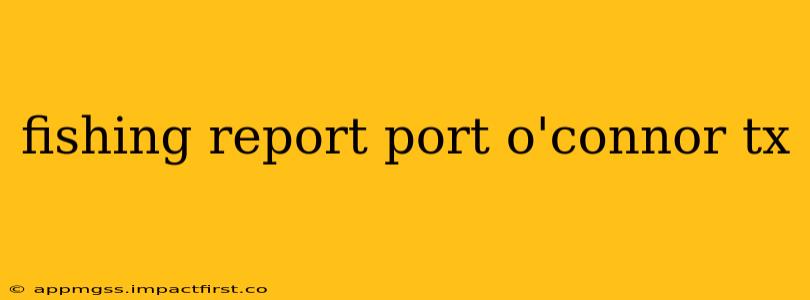Port O'Connor, Texas, a charming coastal town nestled on the shores of Matagorda Bay, is a renowned fishing destination. Whether you're a seasoned angler or a weekend warrior, the diverse waters offer exciting opportunities to hook a variety of species. This fishing report provides an up-to-date overview of the current fishing conditions in Port O'Connor, focusing on what's biting, where to fish, and what techniques are proving most successful. We'll also address some frequently asked questions to help you plan your next fishing adventure.
What's Biting in Port O'Connor?
The fishing scene in Port O'Connor fluctuates with the seasons and tides, but some species remain consistent throughout the year. Currently, [Insert current month and year] is proving to be a productive time for:
-
Redfish: These hard-fighting fish are a staple in Matagorda Bay. Look for them in shallow, grassy flats, along oyster reefs, and around structure. Topwater lures, soft plastics, and live bait are all effective.
-
Speckled Trout: Another popular target, speckled trout thrive in the bay's shallows. Focus your efforts near grass beds, points, and drop-offs. Soft plastics rigged weightless or on a jighead often produce excellent results.
-
Flounder: Known for their delicious taste, flounder are often found in deeper water channels and around structure. Live bait, such as shrimp or croaker, is a reliable choice for flounder fishing.
-
Black Drum: These large, powerful fish are a prized catch for many anglers. Look for them near jetties, oyster reefs, and deeper channels. Fresh-cut bait is usually best.
-
Other Species: Depending on the time of year, you might also encounter other species like sharks, sheepshead, and various smaller game fish.
Where to Fish in Port O'Connor?
Port O'Connor offers numerous fishing locations, catering to different skill levels and preferences:
-
Matagorda Bay: The vast expanse of Matagorda Bay offers a diverse range of habitats, from shallow flats to deeper channels. Exploring different areas within the bay will greatly improve your chances of success.
-
Pass Cavallo: This popular spot is known for its strong currents and abundance of fish. It's particularly productive during migratory periods.
-
Espiritu Santo Bay: This bay offers excellent opportunities to target redfish, speckled trout and flounder. Its calm waters make it ideal for beginner anglers as well.
-
Aransas National Wildlife Refuge: While fishing is restricted in certain areas, the refuge offers fantastic opportunities for wade fishing and sight-casting. (Always check for current regulations and permitted areas.)
What Fishing Techniques are Working Best?
The best fishing techniques depend heavily on the species you are targeting and the current conditions. However, several techniques consistently produce results in Port O'Connor:
-
Topwater fishing: This exciting method works well for redfish and speckled trout during low-light hours.
-
Soft plastics: Versatile and effective for a wide range of species, soft plastics can be rigged in many different ways to match the baitfish in the area.
-
Live bait: Shrimp, croaker, and mullet are all excellent choices for attracting fish.
What is the best time of year to fish in Port O'Connor?
The best time to fish in Port O'Connor often depends on the species you are targeting and your preferred weather conditions. However, spring and fall usually offer ideal temperatures and abundant fish activity.
What kind of fishing license do I need to fish in Port O'Connor?
Texas requires a fishing license for residents and non-residents (with some exceptions). Check the Texas Parks and Wildlife Department website for the most up-to-date licensing requirements and regulations.
What are the current fishing regulations in Port O'Connor?
Fishing regulations in Port O'Connor are enforced by the Texas Parks and Wildlife Department. It's crucial to familiarize yourself with the current size and bag limits for each species before you go fishing. You can find the most accurate and up to date information on their website. Remember to practice responsible fishing and release smaller fish to maintain healthy populations.
Disclaimer: This fishing report is based on current information and may change based on weather patterns, water temperatures, and other environmental factors. Always check local fishing reports and guides for the most up-to-date information before heading out. Remember to always practice safe and responsible fishing practices.
